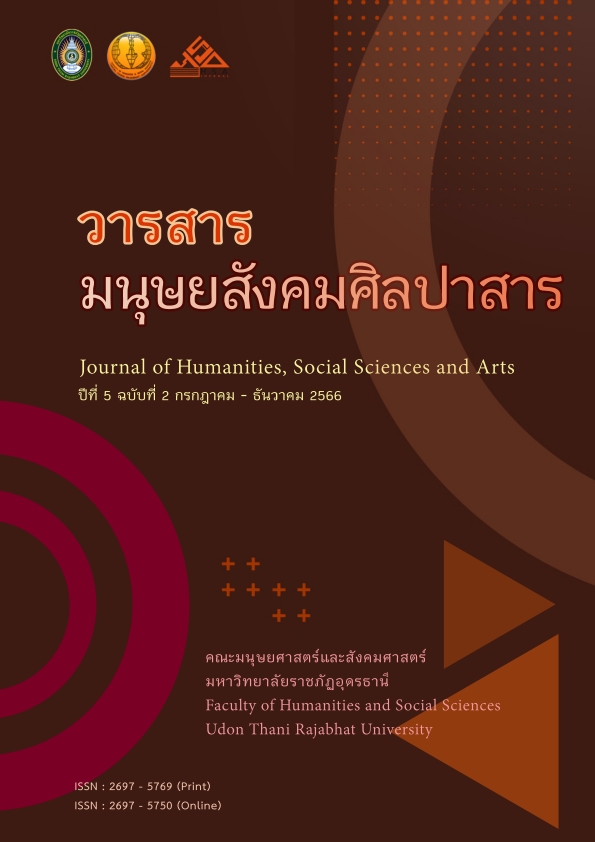HUMAN, ELEPHANTS, AND FOREST: THE COMMUNITY’S NEED IN COPING WITH THE CONFLICT OF CONSERVATION FOREST AREA: A CASE STUDY OF BAN KHAM PIA, BUNG KLA DISTRICT, BUENG KAN PROVINCE
Main Article Content
Abstract
The purpose of the study was to examine the problems and community needs of villagers in Ban Kham Pia Village at Bung Kla district, Bueng Kan Province. The qualitative research was used as a research methodology. The population consisted of the head of Ban Kham Pia Village, Ban Kham Pia villagers, unofficial leaders, folk wisdom philosophers, occupational groups in the community, volunteer staff from public health, staff of sub-district health promotion hospital, staff of local administrative organization, and teachers of Ban Kham Pia School. Simple random sampling was employed in the study and the sample group was selected by using purposive sampling. The data were collected by using an interview form adopted from Chuengsatiansup, K. et.al. (2012) which included 7 community tools that were used for analyzing descriptive data. After gathering, all data were categorized and synthesized by using a content analysis methodology. From the focus group interview and participant observation record, the results revealed as follows: (1) A problem that the community wanted to solve the most was the problem of wild elephants that always invaded agricultural areas. The elephants mostly came at night and destroyed villagers’ rice fields and rubber plantations and sometimes also destroyed people's assets and lives. The cause that was the main factors consisted of the growing number of wild elephants, the invasion of elephants in agricultural areas, the living place and food sources of the elephants were destroyed, and the water resources were insufficient for the need of the elephants. From these problems, there were still no guidelines and models for sustainable solutions. (2) For the needs of Kham Pai Village Community, the villagers preferred having government organizations and other related organizations to help solve the elephants’ problems, area-based management in serious and sustainable problem-solving by having a platform to share opinions, assessing situations, lesson learning from the experience of the community, and magnifying the outcome to government sectors, researchers, and network association before taking the entire data to synthesize as suggestions in the next step to reduce the conflict between human and the elephants based on community participation.
Downloads
Article Details
References
กรมอุทยานแห่งชาติสัตว์ป่า และพันธุ์พืช. (2561). คู่มือการเสริมโป่งช้าง. กรุงเทพฯ: สำนักอนุรักษ์สัตว์ป่า กรมอุทยานแห่งชาติ สัตว์ป่า และพันธุ์พืช.
กลุ่มงานวิจัยสัตว์ป่า. (2557). สถานภาพของสัตว์เลี้ยงลูกด้วยนมขนาดใหญ่ในประเทศไทย : โครงการศึกษาการแพร่กระจายความชุกชุมและประชากรสัตว์เลี้ยงลูกด้วยนมขนาดใหญ่ที่หายาก ใกล้สูญพันธุ์ และมีความสำคัญในระบบนิเวศ. กรุงเทพฯ: สำนักอนุรักษ์สัตว์ป่า กรมอุทยานแห่งชาติ สัตว์ป่า และพันธุ์พืช.
โกมาตร จึงเสถียรทรัพย์ และคณะ. (2555). วิถีชุมชนคู่มือการเรียนรู้ที่ทำให้งานชุมชนง่ายได้ผลและสนุก.นนทบุรี: สถาบันวิจัยระบบสาธารณสุข.
นาย ก. นามสมมุติ. (2561, 10 มีนาคม). ประชาชน. สัมภาษณ์.
รัชนี โชคเจริญ. (2555). นิเวศวิทยาของช้างป่า (Elephas maximus Linnaeus, 1758) ในเขตรักษาพันธุ์สัตว์ป่าภูวัวจังหวัดบึงกาฬ. [ปริญญานิพนธ์วิทยาศาสตรมหาบัณฑิต สาขาวิทยาศาสตร์ชีวภาพป่าไม้ มหาวิทยาลัยเกษตรศาสตร์]. ฐานข้อมูลงานวิจัย (ThaiLis).
ส่วนสารสนเทศด้านอนุรักษ์สัตว์ป่า สำนักอนุรักษ์สัตว์ป่า กรมอุทยานแห่งชาติ สัตว์ป่า และพันธุ์พืช. (2557). แนวเขตพื้นที่เขตรักษาพันธุ์สัตว์ป่าภูวัว บ้านขามเปี้ย อำเภอบุ่งคล้า จังหวัดบึงกาฬ http://www.dnp.go.th/wildlife_it
Barnes, R.F.W. (1996). The conflict Between humans and elephants in the central African Forests. Mammal Review, 26, 67-80.
Dickman, A. J. (2010). Complexities of Conflict: The Importance of Considering Social Factors for Effectively Resolving Human-Wildlife Conflict. Animal Conservation, 13, 458-466.
Graham, A. D. (1973). The Gardeners of Eden. London: Allen & Unwin.
Nelson, A. P., Bidwell & Sillero-Zubiri, C. (2003). A review of humane elephant conflict management strategies. People and Wildlife Initiative. Wildlife London: Conservation Research Unit, Oxford University.
Parker, I.S.C. & Graham, A.D. (1989). Elephant decline: Downward trends in African elephant Distribution and numbers. Parts I & II. International Journal of Environmental Studies, 34, 13-26 & 287-305.
Ville, J.L. (1995). Man and elephant in the Tsavo area of Kenya: an anthropological perspective. Pachyderm, 20, 69-72.


